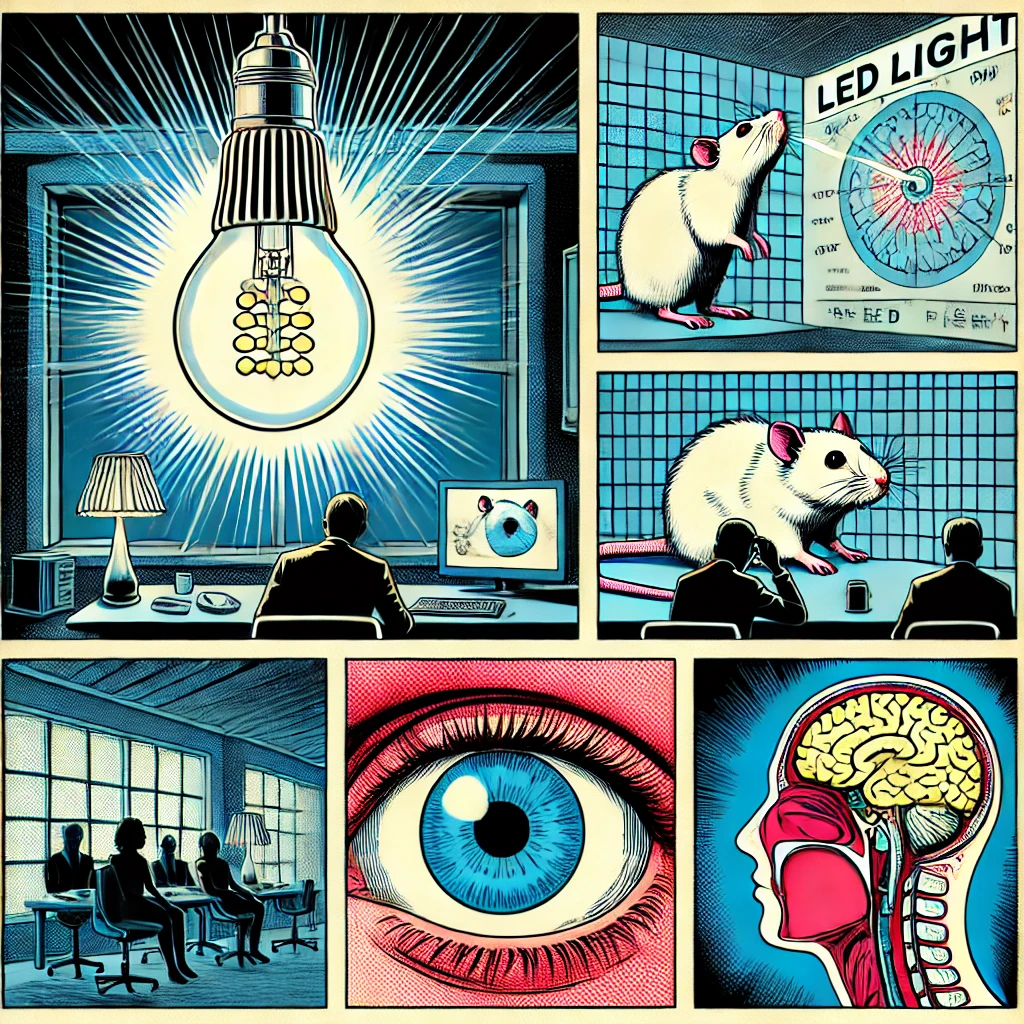White LED lights at domestic lighting levels cause retinal injury in rats and likely humans
‘Light-emitting diodes (LEDs) deliver higher levels of blue light to the retina than do conventional domestic light sources. Study revealed vision cell damage and death per blue-light induced photochemical injury of the retina. Free radical production / oxidative stress in the retina was increased with LED-exposure. Serious retinal light injury caused by LED lights; compact fluorescent lamp (CFL) groups showed moderate to mild injury. Our results raise questions about adverse effects on the retina from chronic exposure to LED light compared with other light sources that have less blue light. Thus, we suggest a precautionary approach with regard to the use of blue-rich “white” LEDs for general lighting.’
This article discusses a 2013 study examining the effects of white LED lights at domestic lighting levels on retinal health in rats, suggesting potential implications for humans. The study, conducted by Shang et al. (2014), found that exposure to white LEDs emitting higher levels of blue light led to significant retinal damage in rats, including apoptosis and necrosis of photoreceptors. This damage was associated with increased oxidative stress in the retina. In contrast, exposure to compact fluorescent lamps (CFLs) resulted in only moderate to mild retinal injury. The researchers concluded that chronic exposure to LED light, which contains more blue light than traditional lighting sources, may pose risks to retinal health and recommended a precautionary approach to the use of blue-rich white LEDs for general lighting.
Further research supports these findings. Wu et al. (2019) demonstrated that continuous exposure to white LED light can cause structural and functional damage to rat retinas, with the severity of damage correlating with the intensity of illumination. Their study emphasized the importance of considering retinal damage risks during LED illumination and suggested that proper LED illumination intensity may help maintain eye health.
https://pubmed.ncbi.nlm.nih.gov/24362357/
Yu-Man Shang 1, Gen-Shuh Wang, David Sliney, Chang-Hao Yang, Li-Ling Lee
- PMID: 24362357
- PMCID: PMC3948037
- DOI: 10.1289/ehp.1307294
Abstract
Background: Light-emitting diodes (LEDs) deliver higher levels of blue light to the retina than do conventional domestic light sources. Chronic exposure to high-intensity light (2,000-10,000 lux) has previously been found to result in light-induced retinal injury, but chronic exposure to relatively low-intensity (750 lux) light has not been previously assessed with LEDs in a rodent model.
Objective: We examined LED-induced retinal neuronal cell damage in the Sprague-Dawley rat using functional, histological, and biochemical measurements.
Methods: We used blue LEDs (460 nm) and full-spectrum white LEDs, coupled with matching compact fluorescent lights, for exposures. Pathological examinations included electroretinogram, hematoxylin and eosin (H&E) staining, immunohistochemistry (IHC), and transmission electron microscopy (TEM). We also measured free radical production in the retina to determine the oxidative stress level.
Results: H&E staining and TEM revealed apoptosis and necrosis of photoreceptors, which indicated blue-light induced photochemical injury of the retina. Free radical production in the retina was increased in LED-exposed groups. IHC staining demonstrated that oxidative stress was associated with retinal injury. Although we found serious retinal light injury in LED groups, the compact fluorescent lamp (CFL) groups showed moderate to mild injury.
Conclusion: Our results raise questions about adverse effects on the retina from chronic exposure to LED light compared with other light sources that have less blue light. Thus, we suggest a precautionary approach with regard to the use of blue-rich “white” LEDs for general lighting.
Citation: Shang YM, Wang GS, Sliney D, Yang CH, Lee LL. 2014. White light-emitting diodes (LEDs) at domestic lighting levels and retinal injury in a rat model. Environ Health Perspect 122:269-276; http://dx.doi.org/10.1289/ehp.1307294.
